This post may contain affiliate links, which means I’ll receive a commission if you purchase through my links, at no extra cost to you. Please read full disclosure for more information.
Why choose to practice yoga for anxiety?
Yoga is one of the best exercises for relieving anxiety.
It’s combination of breathwork, postures, and relaxation can quite quickly relieve anxiety’s common physical symptoms such as tension, tightness, nervousness, and irritability, helping you feel calm and relaxed afterward.
But it’s not only the physical body that benefits.
Yoga is also a great technique for training the mind to be in the present moment which is how you can reduce your negative thoughts, worries, and overthinking.
But it’s not only the physical body that benefits.
Yoga is also a great technique for training the mind to be in the present moment which is how you can reduce your negative thoughts, worries, and overthinking.
There’s plenty of scientific research that can back this up, but I’ve also felt the benefits of yoga on my own mental health and that’s the main reason why I highly recommend yoga for anxiety.
If you’ve never practiced yoga before, don’t worry because there are many different styles to choose from. Some are more physically demanding, while others are easy and relaxing.
And you don’t have to join a yoga studio; there are plenty of awesome YouTube videos to choose form.
In this article, I’ve included everything you need to get started – 12 easy yoga poses for anxiety plus guided videos so I have you covered!
Table of Contents
What is Yoga?
Yoga is believed to have originated in India over 5,000 years ago.
Derived from the ancient Indian language of Sanskrit, the word ‘yoga’ means “yoke” or “union”; as yoga is about bringing together of the mind, body, and spirit.
Yoga includes breathing exercises, meditation, and postures designed to restore balance and promote relaxation.
Yoga postures are also known as poses or asanas.
How Does Yoga Help with Anxiety?
1. Yoga Lowers Tension
Stress and anxiety can create tension in shoulders, neck, jaw, or elsewhere, resulting in more unease.
Yoga poses work to stretch, lengthen, and balance the muscles, which can help to release built-up muscle tension and stiffness throughout the body.
So, practicing yoga can reduce physical tension, leading to decreased symptoms of stress and anxiety.
2. Yoga Increases Resilience to Anxiety
Yoga poses are often taught in sequences, and the faster you move through the sequence the more physically demanding yoga becomes, and as such can be a very powerful form of exercise.
Research shows that exercise:
- Can be used in the treatment of anxiety
- Reduces symptoms of anxiety
- Increases resilience to stress and anxiety
3. Yoga Interrupts Worry Cycles
Yoga not only helps in easing physical symptoms, but it can also help with anxious thoughts.
A common symptom of anxiety is excessive worrying, usually about what might happen in the future.
But when we are focused on the future, we cannot be present in the moment.
Practicing yoga helps to shift focus and attention to body and breath, which helps the mind to come back to the present. Being in the present interrupts worry cycles and is generally more calming for the mind!
Katharina Star, Ph.D., Counsellor with expertise in Anxiety and Panic Disorder Treatment said,
"Negative thinking patterns and frequent worries are common for those diagnosed with [an anxiety] disorder. Meditation, visualization, and focusing on breathing can help with letting go of worry and fear. The overall practice of yoga can elicit the relaxation response, allowing both the body and mind to gain a sense of calm and ease."
4. Yoga Helps to Regulate Breathing
Your breathing is closely linked to your nervous system.
When you are feeling anxious, your breathing becomes shallower, rapid, and constricted, and this causes more stress and anxiety to your nervous system. You might even unconsciously hold your breath and then take big gulping breaths.
But yoga can help you with this!
In yoga, we learn to focus our attention on the quality of our breath as we move through the physical postures, which helps to slow down and deepen breathing and soothe the nervous system.
5. Yoga Connects People
Practicing yoga can be a great way to meet other people. Anxiety often triggers loneliness and isolation especially if you are suffering from social anxiety or agoraphobia.
Participating in a yoga class can be a way to meet other people also working on bringing more relaxation into their life.
What are Different Types of Yoga?
In most yoga classes you’re likely to see asanas from the following categories – twists, standing poses, seated poses, supine/prone poses, backbends, inversions, and restorative poses.
But classes will vary depending on the following:
- Theme / Style (Vinyasa, Ashtanga, Hatha, Restorative, Yin, or other)
- Level (Beginner, Intermediate, Advanced)
- Instructor/Teacher (each teacher is unique)
Some classes will be more physically demanding while others might be easy and relaxing, almost meditative.
In the beginning, it is best to try a few themes, and if possible, also teachers, before settling on your favorite.
Definitely, stick to yoga for beginners’ classes until you become more familiar with yoga postures.
The following yoga styles are popular, and the ones you’re most likely to see in your local yoga studio or gym.
Hatha Yoga
Hatha yoga is often slow-paced and does not follow a flow. This makes Hatha yoga ideal for beginners because you’ll have time to learn yoga asanas, as well as how to breathe correctly while in these positions. If you are new to yoga, I recommend that you initially attend a few Hatha yoga classes.
Vinyasa Yoga
Vinyasa means connection. This style of yoga is about learning to coordinate your inhale and exhale with movement.
The emphasis is on creating a flow between postures, with smooth transitions from one to the next. Vinyasa can be slow and gentle or fast and intense, depending on how basic or advance the class.
Music is often played in Vinyasa classes to keep things lively.
The intensity of the practice is similar to Ashtanga. But, no two vinyasa classes are the same. So, if you are not a fan of routine and are up for a physical challenge, Vinyasa may be for you! Vinyasa classes are also referred to as flow classes.
If you’ve never practiced yoga before, make sure you give Vinyasa some time before giving up. It will be challenging in the beginning, even in basic classes, but after a while, Vinyasa becomes a beautiful practice.
After each Vinyasa class, I’d feel a huge relief in anxiety and it is my favorite style of yoga.
Ashtanga Yoga
Ashtanga is fast-paced and physically challenging. It is similar to vinyasa as each style links every movement to a breath.
The only difference, however, is that the sequence of poses in ashtanga is always practiced in the same order.
Ashtanga starts with a series of sun salutations and then moves into a series of standing and floor postures.
Basic ashtanga classes are also a great way to learn how to correctly practice yoga postures and breathing techniques.
Yin Yoga
Yin yoga is slow-paced with mainly lying down or seated positions that are held for longer periods of time, approximately 5 minutes.
The longer held stretches aim to release tension and restore range of motion to muscles and connective tissue. Yin yoga is particularly beneficial for people who have tight muscles, chronic pain, stress, or anxiety.
Although Yin yoga is not physically challenging, it’s very relaxing and also ideal for beginners.
Restorative Yoga
Restorative yoga is very gentle and asanas are held for 10 minutes or more.
In restorative yoga classes, it’s common to use several props for support and relaxation, such as blankets, bolsters, and straps. Similar to Yin, restorative yoga is particularly beneficial for people who have chronic pain, stress, or anxiety.
What Type of Yoga is Best for Anxiety?
The short answer is that all styles of yoga are great for anxiety.
The long answer is it depends on your personal preference and what type of yoga you’re going to be most comfortable with.
It doesn’t matter whether you choose to practice Vinyasa, Ashtanga, Hatha, Yin, Restorative, or any other type of yoga, all that matters is that you commit to your practice. Practicing yoga regularly is how you will start to notice positive changes in your anxiety.
12 Easy Yoga Poses for Anxiety
The following yoga sequence is designed to help you relieve anxiety. These postures are easy and simple and can become part of your morning or evening routine.
A few points to before you start:
1. Child’s Pose
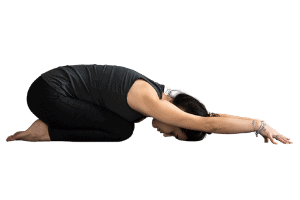
Instructions
- Kneel on a yoga mat, spread your knees in V-shape, or you can keep them together if you wish.
- Reach your arms up and stretch forward as far as you can. Your chest should be resting on your thighs with your forehead on the mat.
- Close your eyes and relax.
- Allow your body to melt into the mat and try to let go as much as possible.
- Breathe Deeply for 5 minutes.
- Allow yourself to melt deeper with each deep breath.
- Watch video instructions
2. Head-to-Knee Forward Bend Pose
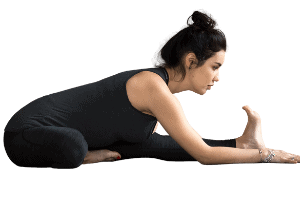
Instructions
- Begin this pose seated with your legs extended.
- Bend your left leg, and bring the sole of your foot to the upper inside of the right thigh. Your left knee should rest on the floor.
- Place both of your hands to either side of the right leg then inhale, turning toward the extended leg.
- Exhale and fold forward.
- Hold for 5 long breaths.
- Repeat the above process on the other side.
- Watch video instructions
3. Bridge Pose
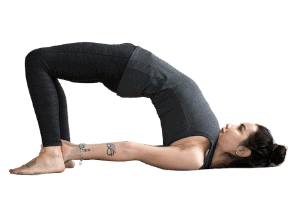
Instructions
- Lie down on your back, bend your knees and place your feet flat on the floor hip-width apart. Slide your arms alongside your body with your palms facing down. Your fingertips should be lightly touching your heels.
- Press your feet into the floor, inhale, and lift your hips up, rolling your spine off the floor. Make sure to keep your knees apart.
- Then, press your arms and shoulders into the floor and lift your chest. Make sure you engage your legs and bottom to lift your hips as high as you can off the ground.
- Hold this position for 5 breathes, then release on an exhale, slowly rolling your spine back down to the floor.
- Watch video instructions
4. Cat-Cow Pose


Instructions
- Come onto all fours. Your hands should be below your shoulders and your knees below your hip bones. Keep your back straight which is a neutral position.
- Then inhale, lower your belly, draw your shoulder blades together and peel open your chest, lifting your gaze to find Cow Pose.
- Exhale, press against your palms, round into your back body as you draw your shoulder blades apart from each other, gazing toward your navel to find Cat Pose.
- Continue these movements following your breath.
- Feel the arching movement up and down throughout your back while inhaling and exhaling with the rhythm of the movement.
- Move slowly to feel the movement of each vertebra of your spine.
- Repeat five times.
- Watch video instructions
5. Standing Forward Bend Pose

Instructions
- Start in a standing position. Exhale forward and bend your knees enough to bring your palms flat to the floor with your head pressed against your legs.
- Feel your spine stretch in the opposite directions, as your head pulls down and in. Then press your hips up and straighten your legs to deepen your stretch.
- Hold for 5 breaths, then bend your knees, inhale arms out to sides, and raise arms and torso up back to a standing position.
- Watch video instructions
6. Easy Pose

Instructions
- Extend your legs in front of the body and sit up straight. Then cross your legs at the shins.
- With your knees wide, place each foot beneath the opposite knee and fold your legs in toward the torso.
- Place your hands on your knees with palms facing down.
- Balance your weight evenly across the sitting bones, align your head, neck, and spine, then gaze ahead with soft eyes.
- Hold for one minute, then release and change the cross of the legs, and hold for another minute.
- Watch video instructions
7. Dolphin Pose
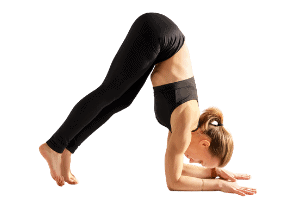
Instructions
- Start on all fours. Lower your forearms to the floor, tuck your toes under and lift your hips towards the ceiling.
- Place your hands shoulder-width apart and spread your fingers wide.
- Press your forearms, fingers, and palms into the floor and press your hips back while keeping your spine straight.
- Keep your feet hips-wide apart and your toes facing forward. Press your heels into the floor.
- Let your head and neck hang freely.
- Remain in this pose for 5 breaths and then return to table pose.
- Watch video instructions
8. Eagle Pose

Instructions
- Begin standing with your arms at the sides.
- Bend your knees, then balance on your right foot, and cross your left thigh over your right. Then hook top of your left foot behind your right calf. Balance in that position for one breath.
- Then extend your arms straight in front of the body and drop your left arm under your right.
- Bend your elbows, raise your forearms perpendicular to the floor, and wrap arms and hands, pressing palms together.
- Square hips and chest to front and draw belly in and up.
- Gaze at the tips of thumbs.
- Hold for long 5 breaths, then gently unwind arms and legs.
- Repeat the above on the opposite side.
- Watch video instructions
9. Puppy Pose
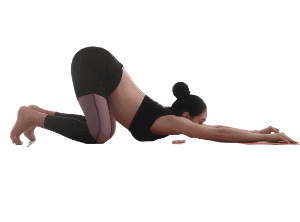
Instructions
- Start on all fours with your shoulders stacked over your wrists, hips stacked over your knees and the tops of your feet relaxed down on the mat.
- Slowly walk your hands out, lowering your chest towards the ground. Keep your hips over your knees with your arms shoulder-distance apart.
- Gently release your forehead to the mat.
- Activate your arms by pressing your palms down and reach your hips up toward the ceiling.
- Relax your neck and breathe into your back, lengthening your spine in both directions.
- Remain in this pose for 5-10 breaths. Then gently lift your forehead and walk your palms back toward your body, returning to all fours.
- Watch video instructions
10. Extended Triangle Pose

Instructions
- Start from a standing position. Exhale, spreading your legs and placing them 4 feet apart from each other.
- Stretch your arms out sideways with palms facing down.
- Turn your right foot out at a 90-degree angle; turn your left foot in toward the right.
- Tighten your thigh muscles, and turn your right thigh outward.
- Bend your body from your hips toward your right leg.
- Twist your body to the left, making sure both sides remain long.
- Push your right hip slightly forward while lengthening your tailbone toward your heel.
- Keep your right hand on your ankle, shin, or the floor and stretch your left arm up towards the sky.
- Keep your head straight or turn it slightly to the left.
- Hold this position for 5 breaths.
- Repeat on the other side.
- Watch video instructions
11. Legs Up the Wall Pose

Instructions
- Sit with your hips against the wall and roll onto your back, taking your legs up the wall.
- Your bottom should be pressed as close to the wall as possible while gently breathing long deep breathes in and out.
- Hold this pose for 5 minutes (restorative pose).
- Watch video instructions
12. Corpse Pose

Instructions
- Lie flat on your back with your legs together but not touching, and your arms at sides with palms up.
- Keep your eyes closed and face relaxed. Breathe deeply.
- Bring attention to each part of your body, starting at the top of the head.
- Hold this pose for 5 minutes (restorative pose).
- Watch video instructions
Breathing Exercises for Anxiety
The following breathing techniques are a fundamental part of yoga practice, but can also be done on their own to help you manage your anxiety.
Controlling your breath in yoga is known as pranayama.
Ujjayi Breathing (Ujjayi Pranayama)
Ujjayi Breathing is very effective at relieving stress and anxiety, and it is most commonly used in Ashtanga and Vinyasa yoga.
Instructions
- Close your mouth and start to breathe in and out through your nose.
- Then begin to inhale through your nose, slightly deeper than normal.
- Exhale slowly through your nose while constricting the muscles in the back of your throat.
- Continue for 5 minutes or more
- Watch video instructions
Alternate Nostril Breathing (Nadi Shodhanam Pranayama)
Alternate nostril breathing helps to slow down inhalation and exhalation.
It balances the parasympathetic and sympathetic nervous system leading to a state of internal tranquility, stability, and peace of mind while balancing and regulating energy through the left and right side of the body.
Instructions
- Use the thumb on your right hand to close the right nostril.
Inhale gently through your left nostril, then close it with your ring finger. - Open your right nostril and exhale.
- Now inhale through your right nostril and then close it with the thumb.
- Exhale through your left nostril.
- Once your exhalation is complete, inhale through your left nostril.
- This is one cycle.
- Continue for up to 5 minutes.
- Watch video instructions
Viloma Breathing (Viloma Pranayama)
Viloma pranayama helps to calm the brain and your nervous system. You can practice this technique either in a seated position or lying down. Viloma pranayama is often practiced at the start or at the end of yoga practice.
Instructions
- Lie down, or sit in a comfortable position.
- Take a deep breath, filling your lungs completely.
- Then exhale fully.
- Now begin interrupted inhalation.
- Inhale for 2-3 seconds, pause, hold the breath for 2-3 seconds. Continue until your lungs are completely full. This may require 4-5 pauses
- Exhale for 2-3 seconds, then pause, hold the breath for 2-3 seconds.
- Continue until your lungs are completely empty.
- This is one cycle.
- Continue for up to 5-7 minutes.
- Watch video instructions
Yoga for Anxiety Workout Video
Yoga for Anxiety – 20 Minute Practice – Yoga with Adriene
Latest posts by Sandra Glavan, Life Coach for Gentle Anxiety Sufferers (see all)
- How to Live Your Best Life as a Highly Sensitive Person? - 14th October 2023
- How to Sleep Better and Longer? Top 5 Tips - 1st October 2023
- How to Let Go of Control and Relieve Anxiety? - 22nd September 2023

Pingback: How to Love Yourself Again? Top 4 Self-Love Tips - Amosuir